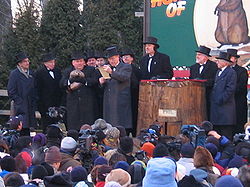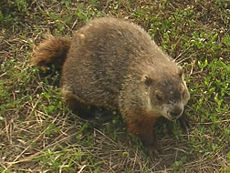Groundhog Day
| Groundhog Day | |
 Groundhog Day 2005 in Punxsutawney, Pennsylvania, USA. |
|
| Observed by | United States and Canada |
|---|---|
| Type | Cultural |
| Significance | Whether the groundhog sees its shadow or not determines how much longer winter will last |
| Date | February 2nd |
| Celebrations | Observing a groundhog emerging from its burrow and seeing whether it sees its shadow, announcing the result of this |
Groundhog Day is a holiday celebrated in United States and Canada on February 2.
In weather lore, if a groundhog, also known as a woodchuck, marmot, or ground squirrel, emerges from its burrow on this day and fails to see its shadow because the weather is cloudy, winter will soon end. If on the other hand, it is sunny and the groundhog sees its shadow, the groundhog will supposedly retreat into its burrow, and winter will continue for 6 more weeks.[1]
Candlemas is usually the same day, and has similar beliefs about the coming weather.
Since the release in 1993 of the film of the same name, Groundhog Day, the phrase is sometimes used in English to mean "the same thing over and over again" particularly in reference to unpleasant repeating cycles.[2][3][4]
Contents |
History
Historical origins

Perhaps the earliest known American reference to Groundhog Day can be found at the Historical Society of Berks County in Reading, Pennsylvania. The reference was made February 4, 1841 in Morgantown, Berks County, Pennsylvania storekeeper James Morris' diary: "Last Tuesday, the 2nd, was Candlemas day, the day on which, according to the Germans,[5] the Groundhog peeps out of his winter quarters and if he sees his shadow he pops back for another six weeks nap, but if the day be cloudy he remains out, as the weather is to be moderate." (Legend has it that the groundhog is a timid creature, and the sight of his own shadow will scare him.[1])
In the United States the tradition may also derive from a Scottish poem:
As the light grows longer
The cold grows stronger
If Candlemas be fair and bright
Winter will have another flight
If Candlemas be cloud and snow
Winter will be gone and not come again
A farmer should on Candlemas day
Have half his corn and half his hay
On Candlemas day if thorns hang a drop
You can be sure of a good pea crop
This tradition also stems from similar beliefs associated with Candlemas Day[6] and Groundhog Day. Candlemas, also known as the Purification of the Virgin or the Presentation, coincides with the earlier pagan observance Imbolc.
Alternative origin theories
In western countries in the Northern Hemisphere the official first day of Spring is about six weeks after Groundhog Day, on March 20 or March 21. About 1,000 years ago, before the adoption of the Gregorian calendar when the date of the equinox drifted in the Julian calendar, the spring equinox fell on March 16 instead. This was exactly six weeks after February 2, assuming that the equinox marked the first day of spring in certain medieval cultures, as it does now in western countries, Groundhog Day occurred exactly six weeks before spring. Therefore, if the groundhog saw his shadow on Groundhog Day there would be six more weeks of winter. If he didn't, there would be 42 more days of winter. In other words, the Groundhog Day tradition may have begun as a bit of folk humor.[7]
Alternatively, the custom could have been a folk embodiment of the confusion created by the collision of two calendrical systems. Some ancient traditions marked the change of season at cross-quarter days such as Imbolc when daylight first makes significant progress against the night. Other traditions held that Spring did not begin until the length of daylight overtook night at the Vernal Equinox. So an arbiter, the groundhog/hedgehog, was incorporated as a yearly custom to settle the two traditions. Sometimes Spring begins at Imbolc, and sometimes Winter lasts 6 more weeks until the equinox.[8]
Famous prognosticators and predictions
As stated earlier, a shadow of a groundhog means six more weeks of winter, and no shadow means spring is around the corner.[9] Groundhog Day proponents state that the rodents' forecasts are accurate 75% to 90%. A Canadian study for 13 cities in the past 30 to 40 years puts success rate level at 37%.[10] Also, the National Climatic Data Center reportedly has stated that the overall predictions accuracy rate is around 39%.[11]
What follows is a record of the various dates accompanied by several of the most famous marmot predictions.
|
|
In fiction
In 1899, members of The Slumbering Groundhog Lodge of Quarryville, Lancaster County, Pennsylvania composed a song about groundhogs sung to the tune of "The Battle Hymn of the Republic":
Let the scientific fakirs gnash their teeth and stamp with rage- Let astrologers with crystals wipe such nonsense from the page- We hail the King of Prophets, who's the world's outstanding Sage- TODAY THE GROUNDHOG COMES! Glory! Glory! to the Groundhog, Glory! Glory! to the Groundhog, Glory! Glory! to the Groundhog, TODAY THE PROPHET COMES![22]
At the end of Disney's 1930 Silly Symphony Winter, a Mr. Groundhog the Weather Prophet comes out of his hole to determine whether or not there will be more winter. At first, he does not see his shadow, but the clouds clear and his shadow appears, causing him to run back inside. At this point, the winds picks up again and winter continues. In the 1979 Rankin-Bass Christmas TV special Jack Frost, a crucial plot point in the story involves Jack casting his own shadow on Groundhog Day for six more weeks of winter. At the end of the story it is revealed that the narrator (voiced by Buddy Hackett) is the groundhog.
The 1993 comedy movie Groundhog Day takes place in Punxsutawney, Pennsylvania, USA on this day (although the majority of the movie was actually filmed in Woodstock, Illinois). The main character (played by Bill Murray) is forced to relive the day over and over again until he can learn to give up his selfishness and become a better person[23].
Also in the episode "Next Question" of the children's animated show As Told By Ginger Carl and Hoodsey liberate the towns Groundhog so they could sell scarves remembering their Groundhog, Pete. When the matter is investigated, a monkey, Mr. Licorice, is in the hole and people think that he ate Pete.
In the episode "The Groundhog Day" of The O.C, Seth Cohen and Che attempt to save the animal used on Groundhog Day in their town of Newport.
On January 9, 2006, the Pennsylvania Tourism Office presented installments of the Groundhog 202 film series, a Groundhog Day promotion that played off The Shining. The film shows what happens when the groundhog, stuck inside for 364 days, goes mad with cabin fever. On January 11, 2007, the Pennsylvania Tourism Office presented installments of the Groundhog Crossing film series, a Groundhog Day promotion that depicted the departure of the Shadow from his friend the Groundhog in an attempt to stop the cycle of winter predictions.
In popular culture, the phrase "Groundhog Day" has come to represent going through a phenomenon over and over until one spiritually transcends it.[24]
Similar customs
In Germany 27 June is "Siebenschläfertag" (Seven Sleepers Day). If it rains that day, the rest of summer is supposedly going to be rainy. While it might seem to refer to the "Siebenschläfer" squirrel (Glis Glis), also known as the "edible dormouse", it actually commemorates the Seven Sleepers (the actual commemoration day is July 25).
In the United Kingdom, 15 July is known as St. Swithun's day. It is claimed that at one time it was believed if it rained on that day, it would rain for the next 40 days and nights. However, since the probability of such a protracted period of continual rain is virtually nil it is more likely that the belief was simply that the ensuing summer would be wetter than average.
References
- ↑ 1.0 1.1 Cohen, H.; Coffin, T.P. (eds.) (1987). The Folklore of American Holidays. pp. 57.
- ↑ http://online.barrons.com/article/SB122488814339968327.html
- ↑ http://firstread.msnbc.msn.com/archive/2008/10/17/1560344.aspx
- ↑ http://www.theaustralian.news.com.au/story/0,25197,24526657-16741,00.html
- ↑ The attribution to the "Germans" may be based on contemporary hearsay or an isolated reference: there is no commonly known tradition in modern Germany relating Candlemas to the weather.
- ↑ "About Groundhog Day". Groundhog.org. Punxsutawney Groundhog Club. Retrieved on 2008-02-04.
- ↑ Groundhog Day, Don Yoder, Stackpole Books, 2003. ISBN 0811700291
- ↑ Groundhog Day, Margaret Kruesi. Journal of American Folklore. Washington: Summer 2007. Vol. 120, Iss. 477; pg. 367+
- ↑ Patton, Jason. "The Shadow Report: Whether Punxsutawney Phil Sees or Doesn't See His Shadow".
- ↑ Phillips, David "Groundhog Day". The Canadian Encyclopedia. Historica Foundation of Canada.
- ↑ "Groundhog Day". Pet Love Shack.
- ↑ "Groundhog Predicts More Winter Weather", Associated Press (2008-02-02).
- ↑ "Wisconsin's Jimmy the groundhog predicts an early spring", Associated Press, WBAY-TV (2008-02-03).
- ↑ West, Shirley (2008-02-03). "Early spring? Dunkirk Dave says yes!", Dunkirk Observer.
- ↑ Limey, Franklin. Pat Lane Calls Early Spring Yet Again! Yankee Herald 3 February 2008.
- ↑ 16.0 16.1 16.2 "Canada's groundhogs agree: Spring's coming early", CTV (2008-02-02).
- ↑ Stradling, Richard. "2008-02-03", The News & Observer.
- ↑ 18.0 18.1 Lytle, Steve (2008-02-02). "Charlotte's groundhog sees shadow", The Charlotte Observer.
- ↑ 19.0 19.1 "An early spring, says Malverne Mel", Newsday (2008-02-02).
- ↑ ""West Indies Wilbur" Predicts Six More Weeks of Winter", Live From St. Kitts (2008-02-02).
- ↑ "Buckeye Chuck Fails to See Shadow", WCMH (2008-02-02).
- ↑ Anthony Aveni, The Book of the Year: A Brief History of Our Seasonal Holidays (Oxford: Oxford University Press, 2004), 30-31.
- ↑ Groundhog Day (1993)
- ↑ "The spiritual power of repetitive form: Steps toward transcendence in Groundhog Day." Suzanne Daughton, Critical Studies in Mass Communication. Annandale: Jun 1996. Vol. 13, Iss. 2; pg. 138, 17 pgs
Further reading
- Aaron, Michael A., Brewster B. Boyd, Jr., Melanie J. Curtis, Paul M. Sommers, Punxsutawney's Phenomenal Phorecaster. The College Mathematics Journal, Vol. 32, No. 1 (Jan., 2001), pp. 26-29 doi 10.2307/2687216
- Cohen, H., and T. P. Coffin. The Folklore of American Holidays. Detroit: Gale Research, 1987.
- Old, W. C., and P. Billin-Frye. The Groundhog Day Book of Facts and Fun. Morton Grove, IL: Albert Whitman, 2004.
- Pulling, A. F. Around Punxsutawney. Charleston, S.C.: Arcadia, 2001.
- Yoder, Don Groundhog Day. Mechanicsburg, PA: Stackpole Books, 2003.
External links
- History of Groundhog Day
- Groundhog Day History
- Groundhog Day and Gardening A gardener's reflections on Groundhog Day.
- Collection of links to websites about Groundhog Day
- A Collection of Groundhog Crossing Videos Pennsylvania's most famous groundhog, Punxsutawney Phil crosses America
- Profile of many other prognosticating groundhogs
- Punxy Phil's Past Predictions: http://www.groundhog.org/about/predictions.php
|
|||||||
